Dual battery in the tub of a dual cab, how to?
Submitted: Sunday, Jul 02, 2017 at 17:49
ThreadID:
135189
Views:
21496
Replies:
4
FollowUps:
29
This Thread has been Archived
SKEB
G'day all, quick question re an easy set up.
Just finally updated my 15yo Prado to a 2016 hilux dual cab, for a variety of reasons it suits me to have my dual battery in
the tub. Now, my brain is hurting from all the reading and researching and I'm no closer to being able to decide on a easy to install and practical set up.
I would like the battery to be able to be charged from the car whilst driving and solar when camping(dcdc charger?), I will be taking the battery out when not in use so I really don't want any fragile or live cables/gear left in
the tub.
Has anyone installed a similar set up and how did you do it with what gear?
All suggestions welcome. Thanks, Simon.
Reply By: Member - Roachie - Sunday, Jul 02, 2017 at 18:21
Sunday, Jul 02, 2017 at 18:21
My suggestions:
1). run a pair of 6mm square (with 40 amp auto-reset circuit breaker near starter battery) cables from starter battery to
the tub. Make sure the hole in
the tub's floor is insulated with a rubber grommet.
2). Inside
the tub, mount a DC-DC charger which has the capability of a solar input.
3). Wire up the feeds from the starter battery and the solar panel/s to the DC-DC charger.
4). Run a short cable from the output of the DC-DC charger to an Anderson plug.
5). Mount the battery how you want it and have the POS and NEG cables with an Anderson plug on the end. Add-in another 40amp circuit breaker.
Personally I would be providing a decent "permanent" battery box and leaving the battery in there full-time. Such box (made from aluminium for example) would have the required output socket/s and probably a small digital volt meter.....something like this:
http://www.ebay.com.au/itm/12V-Power-Dual-Car-Cigarette-Lighter-Socket-USB-Adapter-Digital-Voltmeter/302328397764?ssPageName=STRK%3AMEBIDX%3AIT&_trksid=p2057872.m2749.l2649
or this....:
http://www.ebay.com.au/itm/Dual-USB-Charger-Voltmeter-12V-Socket-Switch-Panel-Marine-Car-Truck/132148067676?ssPageName=STRK%3AMEBIDX%3AIT&_trksid=p2057872.m2749.l2649
Roachie
AnswerID:
612285
Follow Up By: IvanTheTerrible - Sunday, Jul 02, 2017 at 18:36
Sunday, Jul 02, 2017 at 18:36
Pretty much how we do them but we run the cable in through the rear of
the tub behind the taillights. We fit power sockets and the Anderson plug to the top of the battery box. The plus to having it removable is you have a portable power supply.
FollowupID:
882487
Follow Up By: SKEB - Sunday, Jul 02, 2017 at 19:28
Sunday, Jul 02, 2017 at 19:28
Thanks Roachie and Ivan.
This was one of the options I've been looking at, questions on this..
Do I need to run two cables from the main battery or can I attach a short negative cable to chassis near
the tub and just run the positive from the main? Would that present any problem?
Any suggestions on a really durable DC-DC charger that could stay permanently in
the tub?
Cheers, Simon.
FollowupID:
882491
Follow Up By: Member - Roachie - Sunday, Jul 02, 2017 at 20:12
Sunday, Jul 02, 2017 at 20:12
I prefer to run a negative cable too, for anything that really needs a good earth. The circuit (any circuit) is only as good as it's earth return connection. Not so bad or important for a light or some other small appliance etc.
As for DC-DC.....I've always used Redarc gear and couldn't be happier.
https://www.ebay.com.au/i/272683104668?chn=ps&dispItem=1
Roachie
FollowupID:
882493
Follow Up By: IvanTheTerrible - Sunday, Jul 02, 2017 at 20:22
Sunday, Jul 02, 2017 at 20:22
Plus most new utes dont have a good earth on the chassis. Projecta for DC-DC. I find Redarc overpriced and some of their stuff can be unreliable.
FollowupID:
882494
Follow Up By: IvanTheTerrible - Sunday, Jul 02, 2017 at 20:30
Sunday, Jul 02, 2017 at 20:30
A cheaper way of doing it would be to do away with the DC charger and run a solenoid for the dual battery and a solar reg for the solar. You would need bigger cable on the dual battery setup
FollowupID:
882495
Follow Up By: Member - Phil G (SA) - Monday, Jul 03, 2017 at 09:31
Monday, Jul 03, 2017 at 09:31
Simon, regarding the DC-DC charger, I've had a couple of Ctek D250S which have done the job perfectly. But for our caravan I recently installed the Projecta IDC25. Its a 25A DC-DC with good temperature compensation and a remote temp sensor that you attach to the battery. It preferentially takes power from the solar panels then tops up with power from the alternator - so uses both sources together. I've measured it all when up north last month and it works as stated. Cost under $300.
Main issue I've had with solar regulators (like the Steca 3030 and copies) is that some of the 12/24V models will revert to 24V charging when you switch off or disconnect the battery. That happens when they see the 20V from the solar panel with no power from the battery. You then find your battery is gassing from unregulated current from the panels. That's the main reason I changed my caravan setup.
FollowupID:
882508
Follow Up By: SKEB - Monday, Jul 03, 2017 at 10:37
Monday, Jul 03, 2017 at 10:37
Thanks Ivan,
Previously had Solenoid in last set up and looking at moving to DC-DC this time mainly due to the increase in charging ability (more use from the battery's stated 120AH capacity) and the ability to plug in my current solar that has no regulator. In saying that I may have miss-interpreted all the reading I have been doing and completed messed up the DC-DC chargers ability with something else.
Thanks Phil,
I have not looked at the Projecta yet, had been looking at the Ctek as a mate has one in his set up currently. The more I look the more options there seems to be, hence getting my head around it is taking more time than I had thought.
Cheers guys.
Simon.
FollowupID:
882510
Follow Up By: Sand Man (SA) - Tuesday, Jul 04, 2017 at 07:59
Tuesday, Jul 04, 2017 at 07:59
Hi Simon,
Moving to a DC-DC charger will not provide an increase in overall charging ability.
A DC-DC charger will give a maximum charging current of 20-25 amps, depending on what brand you invest in and therefore will take much longer for the battery bank to reach a full charge when charging from the vehicle alternator.
Now here is the kicker. A battery is unlikely to reach a full charge, unless you are employing a smart charger such as the DC chargers provide with their multi-stage charging processes. Direct charging without a DC charger usually employs some sort of vsr gadget, (voltage sensitive relay) and these devices prohibit a full charging process reaching the battery.
So you have a compromise. Quicker charging direct from an alternator and vsr, or a slower but more complete charging process (if you drive long enough) via a DC charger.
What do I use?
I have two DC chargers. One to charge the 100Ah auxiliary battery in
the tub and another in the camper to support a 200Ah battery bank.
Just as long as you are aware that the charging process will be slower, but more complete, by using a DC-DC charger in your setup.
FollowupID:
882550
Follow Up By: Sand Man (SA) - Tuesday, Jul 04, 2017 at 08:05
Tuesday, Jul 04, 2017 at 08:05
Hi Simon,
Moving to a DC-DC charger will not provide an increase in overall charging ability.
A DC-DC charger will give a maximum charging current of 20-25 amps, depending on what brand you invest in and therefore will take much longer for the battery bank to reach a full charge when charging from the vehicle alternator.
Now here is the kicker. A battery is unlikely to reach a full charge, unless you are employing a smart charger such as the DC chargers provide with their multi-stage charging processes. Direct charging without a DC charger usually employs some sort of vsr gadget, (voltage sensitive relay) and these devices prohibit a full charging process reaching the battery.
So you have a compromise. Quicker charging direct from an alternator and vsr, or a slower but more complete charging process (if you drive long enough) via a DC charger.
What do I use?
I have two DC chargers. One to charge the 100Ah auxiliary battery in
the tub and another in the camper to support a 200Ah battery bank.
Just as long as you are aware that the charging process will be slower, but more complete, by using a DC-DC charger in your setup.
FollowupID:
882551
Follow Up By: SKEB - Tuesday, Jul 04, 2017 at 09:09
Tuesday, Jul 04, 2017 at 09:09
Thanks Bill,
I guess what I was trying to say, not to
well though, was being able to charge the battery more complete and being able to get more out of the stated capacity (actually getting it close to full charge). Happy to have the slower charge of the DC-DC setup as you described.
Cheers. Simon.
FollowupID:
882553
Follow Up By: Member - Phil G (SA) - Tuesday, Jul 04, 2017 at 09:24
Tuesday, Jul 04, 2017 at 09:24
Restrict the charge current can be good for an AGM and that is one of the many good reasons to use a DC-DC charger.
Many AGM manufacturers have an initial charge current restriction to no more than 25-30A (for 100-120 Ah). If you exceed that current, the battery will vent and lose capacity.
I once had a 100Ah AGM in the canopy, big wires to charge it from the alternator. Measured 46 amps going in at times and thought that was great. But the battery was dead in a little over 12 months despite never going under 50% charge in a cool environment in the canopy. Guy at the battery
shop warned me to never let it have unrestricted charge from the alternator.
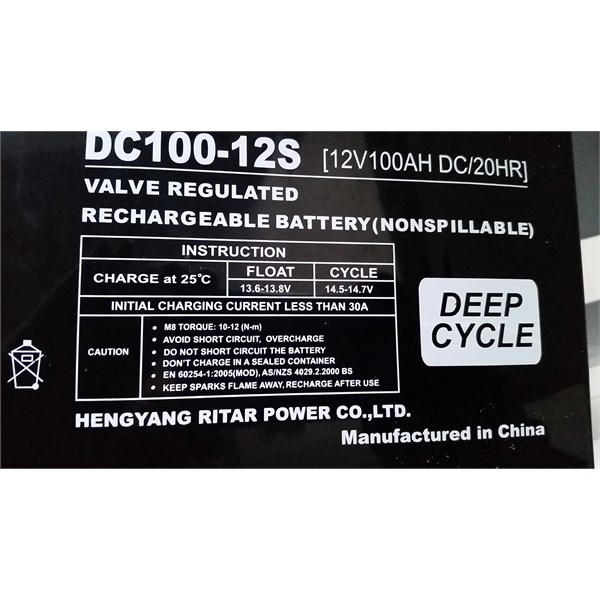
AGM battery
FollowupID:
882556
Follow Up By: Allan B (Sunshine Coast) - Tuesday, Jul 04, 2017 at 09:50
Tuesday, Jul 04, 2017 at 09:50
.
Absolutely agree with you Phil.
My pair of AGM's are charged each with its own 20 Amp dc-dc charger.
Both batteries are now 6 years old and going strong.
Previous AGM directly on the alternator and in the engine bay lasted 18 months.
Connecting directly to the alternator does not necessarily provide significantly faster full-charge times. It can depend on alternator output voltage which, with recent vehicles is decreasing.
With direct alternator charging, high currents may be achieved initially when the battery is at a low state of charge but as the battery voltage rises and the difference between alternator and battery decreases, the charge current will progressively decrease. With a dc-dc multi-stage charger, the initial charge current is maintained throughout the 'bulk charge' phase so the contribution over a given period is improved.
If a person is determined to 'save money' by shunning dc-dc charging they would do better to also economise by purchasing a 'hybrid' auxiliary battery which will accept a higher charge current. But they would then need to be careful regarding depth of discharge. There is no simple cheap way to get good performance from lead-acid battery storage.
FollowupID:
882561
Reply By: Frank P (NSW) - Sunday, Jul 02, 2017 at 20:18
Sunday, Jul 02, 2017 at 20:18
Simon
Have a look at Thread 135146. Most, maybe all, of your questions are answered there.
Cheers
AnswerID:
612287
Follow Up By: SKEB - Monday, Jul 03, 2017 at 10:40
Monday, Jul 03, 2017 at 10:40
Thanks Frank,
Had not looked at that thread due to the title. It certainly presents some interesting points and adds to all the other info floating around in my head.
It has clarified some points that had been raised earlier and answered some others that I had not even thought about.
Cheers.
FollowupID:
882511
Reply By: Member - graeme W (WA) - Monday, Jul 03, 2017 at 00:14
Monday, Jul 03, 2017 at 00:14
As the replies say both methods of connection will be ok , but unless there is a particular reason to remove the battery why not put it under the cab between the mudguard and the cab. I will be putting two auxiliary batteries in this way in either a dual or double cab. A 120 amp hour will just fit. You may have to remove the mudguard to get it in . Remember that the battery can go in on its side. I have two mounted on there side in my truck that have been that way for 10 years. And another possible location is mounting under the cab at the back on the main cross tow hitch support.
cheers Graeme.
AnswerID:
612293
Follow Up By: SKEB - Monday, Jul 03, 2017 at 10:44
Monday, Jul 03, 2017 at 10:44
Thanks Graeme,
Hadn't considered putting it under the cab as in all the camping we have done previously we have at times found it useful to have a removable battery source, as
well as the odd time at
home when the camping is forced upon us from storms/power out etc.
In saying that, murphy's law will strike and I will never take the battery out again...
Cheers, Simon.
FollowupID:
882512
Reply By: Grizzle - Monday, Jul 03, 2017 at 12:50
Monday, Jul 03, 2017 at 12:50
Have just done what you are looking for, we put a false floor in
the tub (very easy to do) Not sure if you private message on here but i can send you pics and description of how we did it. Battery box and all.
AnswerID:
612296
Follow Up By: SKEB - Monday, Jul 03, 2017 at 14:46
Monday, Jul 03, 2017 at 14:46
Thanks Grizzle,
Not a 'paid' member so cant private message on here. Would have been interesting to see your setup.
Cheers.
Simon.
FollowupID:
882518
Follow Up By: Graham G4 - Monday, Jul 03, 2017 at 15:32
Monday, Jul 03, 2017 at 15:32
Ok, cool. I'll try and describe
FollowupID:
882520
Follow Up By: Graham G4 - Monday, Jul 03, 2017 at 15:43
Monday, Jul 03, 2017 at 15:43
False floor, marine ply, melamine, chipboard whatever. Cut to fit tub floor then carpet. Use piggy back fuse holder from something that is switched on the accessories circuit. Run a continuous live and earth with a 40 amp resettable breaker from your main battery to your tub. Run a switching wire from the piggy back fuse along with your permanent live.
Terminate live, earth and switching wire with 75 amp Anderson power pole connectors. You can clip them together in a triple plug.
Buy a standard battery box, fit the biggest battery you can in there. Buy a redarc dc-dc charger with inbuilt solar switching. Autoelecau on eBay sell them cheap. We have bought heaps of stuff from them no drama. Bolt the charger to the underside of the battery box lid and wire to battery. Also put whatever connectors you want in there. Cut slots in your false floor to allow for straps to hold down your battery box and fridge etc. when you don't want to use it, unplug connector and remove whole false floor along with battery, fridge etc. you don't need to bolt false floor down so no drilling in tub.
FollowupID:
882522
Follow Up By: Grizzle - Monday, Jul 03, 2017 at 16:01
Monday, Jul 03, 2017 at 16:01
Don't know what happened there but it was me typing that
FollowupID:
882523
Follow Up By: SKEB - Monday, Jul 03, 2017 at 18:45
Monday, Jul 03, 2017 at 18:45
Thanks Grizzle , something further to consider. Hadn't thought of false floor due to work needs, but you never know.
Simon.
FollowupID:
882525
Follow Up By: Dean K3 - Monday, Jul 03, 2017 at 20:32
Monday, Jul 03, 2017 at 20:32
Will need bcdc charger both Prado and Hilux have smart alternators - and you probably had same issues I have with auxiliary battery basically flat overnight when running fridge. - 08 Prado myself
Pictures can be posted on here just matter of how big and how many at one time. So G4 should be able to add them if he has photographic records
FollowupID:
882531
Follow Up By: Grizzle - Monday, Jul 03, 2017 at 20:51
Monday, Jul 03, 2017 at 20:51
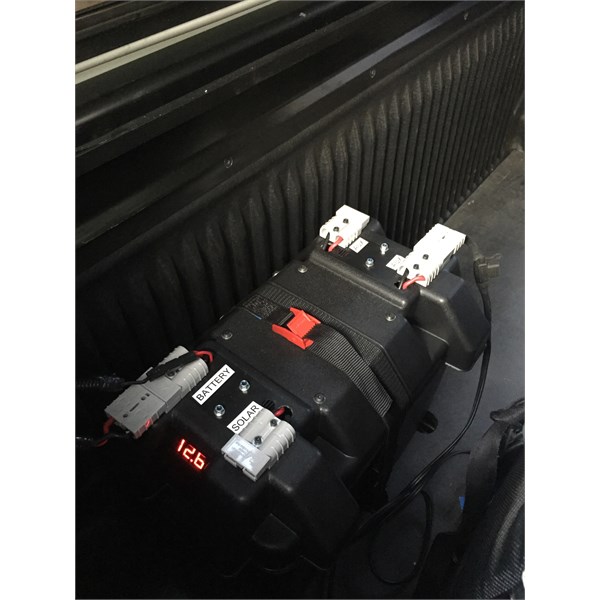
Dual vattery
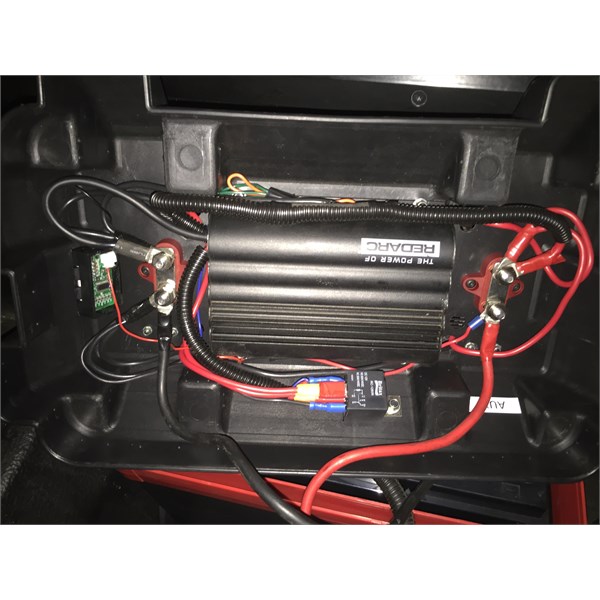
Dual battery
FollowupID:
882532
Follow Up By: Grizzle - Monday, Jul 03, 2017 at 20:52
Monday, Jul 03, 2017 at 20:52
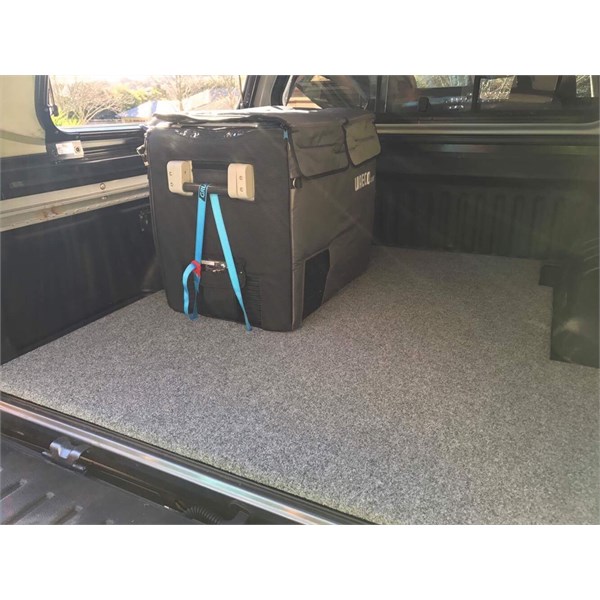
False floor
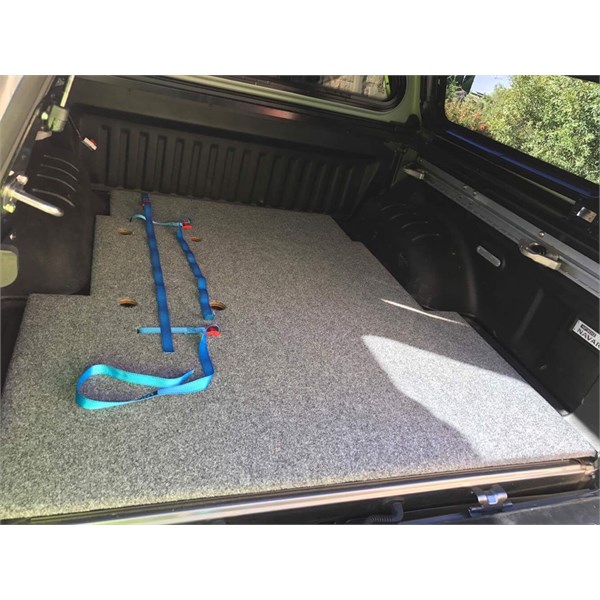
False floor
FollowupID:
882533
Follow Up By: Grizzle - Monday, Jul 03, 2017 at 20:54
Monday, Jul 03, 2017 at 20:54
Wiring on underside of battery box lid is a bit messy as that is the earlier redarc charger that needed a separate relay for solar switching. The new ones switch automatically so wiring is much easier
FollowupID:
882534
Follow Up By: Grizzle - Monday, Jul 03, 2017 at 20:58
Monday, Jul 03, 2017 at 20:58
Round holes in the false floor are to locate the fridge feet so it doesn't slide around. We cut slots to feed the straps through. Takes less than 10 minutes to put in and take out. Battery sits behind the fridge. When it's all out the only thing left in
the tub is the Anderson plug from the front of the car.
FollowupID:
882535
Follow Up By: Grizzle - Monday, Jul 03, 2017 at 20:59
Monday, Jul 03, 2017 at 20:59
False floor just slides in and out
FollowupID:
882536
Follow Up By: SKEB - Monday, Jul 03, 2017 at 21:21
Monday, Jul 03, 2017 at 21:21
Thanks Grizzle, couldn't quite work it out without the pictures, initial thoughts had the false floor a lot higher off
the tub floor.
That would actually work quite
well for my work and play needs.
Without the false floor being attached to
the tub, do you notice any 'bounce' or movement of the battery or fridge? That's probably my only concern.
Cheers, Simon.
FollowupID:
882537
Follow Up By: Grizzle - Monday, Jul 03, 2017 at 21:26
Monday, Jul 03, 2017 at 21:26
No bounce or movement, floor is located sideways in tub, when tailgate is closed it locked it in. By the time you have fridge, battery and all your gear in if it bounces you are already in a world of trouble!!! :)))
We are in
Melbourne eastern suburbs. No drama if you are nearby and want to view.
FollowupID:
882538
Follow Up By: SKEB - Tuesday, Jul 04, 2017 at 09:17
Tuesday, Jul 04, 2017 at 09:17
Thanks for the offer Grizzle, unfortunately I am about a 1000km's away on the Central Coast of NSW.
I have always ratchet strapped my gear down from the tie down points and never had to worry about the unforeseen 'bounce', just something I have always done with kids in the car. I was looking at putting some additional tie down points in
the tub as the ones Toyota supply are minimal and not in the best position, that, plus your set up seems to be what I will head for.
Thanks for the photos and help.
Cheers.
Simon.
FollowupID:
882554
Follow Up By: Grizzle - Tuesday, Jul 04, 2017 at 11:39
Tuesday, Jul 04, 2017 at 11:39
No worries Simon,
If you need any more info or pics let me know.
Cheers,
Graham
FollowupID:
882564